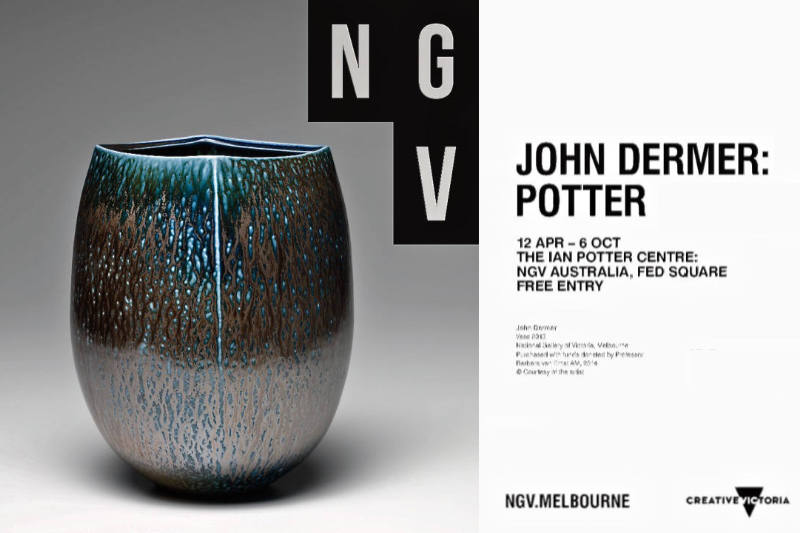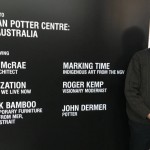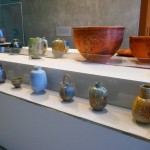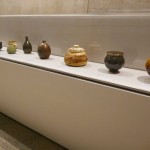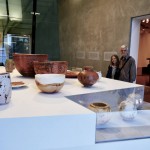From the 12th April until the 6th of October 2019, the National Gallery of Victoria ran a survey exhibition of John’s work.
Read the article by Gaye Pattison and Allison Jess on the ABC (Goulburn Murray) News site at this link, or archived below.
In conjunction with the exhibition the NGV also produced this short video.
John Dermer: Potter
David Hurlston
A potter is one of the few people left who uses his natural faculties of heart, head, and hand in balance. — His is a way of life. Good pots require the ardour of vocation and the devotion of a lifetime.
Bernard Leach, c. 1950 [1]
John Dermer is part of a long and noble tradition of artist-artisans who have used the humble medium of clay to design and create functional and visually pleasing objects. The finest examples of the potter’s art are a combination of skill borne of years of commitment and an innate aesthetic judgement. There is integrity and honesty in every one of Dermer’s hand-crafted pieces; they are the result of a lifetime of dedication to the medium and reflect the creativity and sensitivity of the maker.
John Dermer was born in Melbourne in 1949. In 1968, he undertook graphic art at the Preston Institute of Technology before enrolling at the Royal Melbourne Institute of Technology (now RMIT University) in 1969 where he studied ceramics. In the early 1970s Dermer travelled extensively throughout Japan, Europe, England and America where he consolidated his learnings working for some of the world’s most important pottery studios.
Dermer worked as a production thrower at Michael Leach’s Yelland Pottery, Devon, in the middle of 1971, and in October 1971 joined Wedgwood Pottery, Stoke–on-Trent, Staffordshire, as Artist in Residence. [2] During his twelve months at Wedgwood Pottery, Dermer produced one-off works. As he explains:
The pieces I made were identified as Wedgwood pieces. Some were used as gifts to foreign dignitaries, some are in museums and there are many private Wedgwood collectors both in Australia and overseas who have my pieces in their collections. [3]
At the beginning of 1973, Dermer returned to Australia and in October 1974 established his home and studio, Kirby’s Flat Pottery, at Yackandandah in north-eastern Victoria. The buildings he constructed by hand, using posts cut from the surrounding bush and walls made from mudbricks, have served as a comfortable home and productive workspace for more than forty years. From his studio Dermer produces a range of highly sought-after tableware. It is, however, his exhibition pieces, his distinctive salt-glazed porcelain forms and his vessels that employ the terra sigillata technique, which truly distinguish his practice.
Dermer has been a passionate exponent and dedicated experimenter in the salt-glazing process since his earliest trials using packets of cooking salt, which he poured into a hot kiln as a young potter in 1967. In 2006 his achievements in the technique were recognised when he was awarded the International Salzbrand Keramik Prize in Koblenz, Germany. Currently Dermer conducts six to eight firings per year that are for exhibition pieces and are in addition to his regular firings of high-fired production ware. The salt-glazed works he has produced over the last five years are widely regarded as some of his finest and most resolved.
For Dermer creating his salt-glazed pieces begins with a wheel-thrown form, which he then carefully models using his hands and special tools while the porcelain clay is still in a plastic state. Once dry the work is bisque fired to 1000 degrees and then specially prepared mineral oxides are sprayed in thin layers on to the surface before the piece is placed into a gas-fired kiln for the glaze firing. Once the kiln reaches the around 1300 degrees centigrade Dermer progressively introduces salt directly in front of the gas burners in the firing chamber. As Dermer explains, ‘I use a scoop of salt, about 700 grams, and tip it in front of the burner and it goes off like a whip crack as the moisture comes out’. Over a period of an hour a total of 12 kilograms of salt is introduced into the kiln.[4]
The salt immediately volatilises and the sodium in the salt reacts with the silica in the clay body to form a hard glassy coating. Dermer has taken this process, which was originally used as a cheap and effective way of glazing industrial wares such as clay sewer pipes and acid jars, to an extraordinary new level where the finished form acquires a deep, rich iridescence becoming a piece that is both visually and physically balanced and of jewel-like beauty.
What makes Dermer’s salt-glazed pots so unique is that he is able to get the oxides to suspend in the glaze surface. Dermer points out: ‘I’m doing what shouldn’t really happen, as the glaze is being formed on the pot I’m trying to get the oxides to float in the glaze’.[5] The range of mineral oxides Dermer uses to achieve his effects includes titanium, copper, iron and rutile. The exquisite surfaces are the result of years of development. Despite this, and the detailed records he keeps on every firing, there is still an element of kiln magic involved and no two firings are quite the same, as Dermer explains:
‘Forty-eight hours after the firing is complete you can open the kiln and hopefully there’s some pots in there!’[6]
Dermer has created a beautiful and tranquil garden setting for his house and studio in Yackandandah. Located at the top of a hill overlooking the Australian Alps, the scenery and colours of the surrounding environment are reflected in the rich surfaces of his salt-glazed work and provide a continuing source of creative inspiration, as the artist says:
I want the pot to reflect a process, whether that’s through me as the potter, whether it be my response to influences like the environment and certainly the salt-glazed pots reflect this area here and my terra sigillata pots certainly reflect my travels in the desert. For me it’s really important that the final piece reflects both the maker and the process. [7]
Dermer also has a love for the harsh desert environment of central Australia and has been a regular traveller through these regions. His terra sigillata pieces with their warm ochre surfaces are an example of his ability to develop a technique that enables him to express a personal response to these places and experiences.
Terra sigillata has its origins in Roman times and is commonly seen in works from the first century AD. Originally a method used to seal the surface of a vessel it involves applying a highly refined liquid clay that melts into a glaze-like coating, which then fuses to the clay body when fired. After application, the surface is allowed to dry slightly before being burnished with a lambswool pad that imparts a satin-like sheen to the finished piece.
Dermer is a pioneer in the contemporary use of terra sigillata. He has spent many years developing a special process where, after applying the liquid clay, he wraps the pot in a cocoon of ceramic fibre; that is, a flexible refractory insulating blanket. Within this he encloses various materials: casuarina (sheoak) branchlets and course salt and these are placed in direct contact with the surface of the piece. He then binds the package with wire and fires it in the kiln to 1000 degrees centigrade.
The effects are dramatic: the ash from the casuarina sears itself into the clay and combines with the oxides and salt to etch the surface creating halos of colour and evocative impressions. These pots have a natural beauty and carry the indelible mark of the maker.
Over the course of a remarkable fifty-year career John Dermer has achieved an international reputation as a master craftsman. He is one of Australia’s most respected living potters. Recognised as a leading figure in creative innovation, and at the same time a strong advocate for tradition, he holds a preeminent place in the history of studio pottery in this country. In Dermer’s own words:
Reflecting on the past fifty years I’m quite proud to say I’ve been able to survive by my hands, while being blessed with some magic and timeless pots along the way (8)
Notes
1 Bernard Leach, ‘Belief and Hope’, unpublished paper, c. 1950. Quoted in Garth Clark (ed.), Ceramic Art: Comment and Review 1882 – 1977, E. P. Dutton
(publisher), New York, 1978, p. 86. Bernard Leach was instrumental in the development and popularity of modern-day studio ceramics. Leach was also a writer and in
1940 published A Potter’s Book the first treatise to be written by a potter. Often referred to as the ‘potter’s bible’, it is still in print today.
2 Michael Leach was the youngest of Bernard Leach’s two sons both of whom were professional potters.
3 This and the following quotes by the artist have been transcribed from a recorded interview with the author undertaken on 21 February 2019, Yackandandah.
4 ibid.
5 ibid.
6 ibid.
7 ibid.

